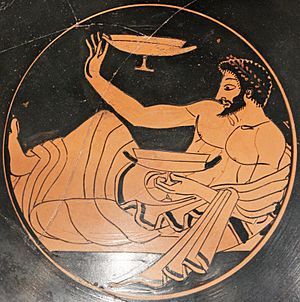Kottabos (Kleophrades Painter) facts for kids

The Kottabos Player is a special ancient Greek vase, specifically a type of drinking cup called a kylix. It was made around 500 BC during the Greek Archaic period. This beautiful vase is known for its "red-figure" style, meaning the figures are red against a black background.
It was likely painted by an artist who worked closely with a famous painter known as the Kleophrades Painter. Today, you can see this historical piece at the Metropolitan Museum of Art in New York City. The vase shows a person playing an old Greek party game called kottabos.
Contents
What is the Kottabos Player Vase?
This ancient Greek vase is a type of cup called a kylix. A kylix was a shallow, wide drinking cup with two handles. People in ancient Greece used these cups at social gatherings. The Kottabos Player vase is made from terracotta, which is a type of baked clay.
The vase is famous for its red-figure painting style. In this technique, the background of the vase is painted black, and the figures are left in the natural reddish color of the clay. This creates a striking contrast that makes the images stand out.
How Big is This Ancient Cup?
The Kottabos Player kylix is not very large. With its handles, it stands about 3 3/16 inches (8.1 cm) tall. Its width, including the handles, is about 10 1/16 inches (25.5 cm). The bowl itself has a diameter of about 7 5/8 inches (19.3 cm). These measurements show it was a comfortable size for holding and using.
What is Kottabos?
The main scene on the vase shows a person playing kottabos. This was a popular party game in ancient Greece. It was often played at social gatherings called symposia (plural of symposium). A symposium was a get-together where men would eat, drink, discuss philosophy, and enjoy entertainment.
How Was Kottabos Played?
The game of kottabos involved skill and aim. Players would try to flick the last drops of liquid from their cup at a target. The target was often a lamp stand or a special stand with small dishes. The goal was to knock down a small disc or finial from the target.
The person on the vase is shown in the middle of this action. They are about to flick the liquid from their cup. If they successfully knocked the target down, they would win the round. It was a fun way to test one's aim and coordination during a party.
Ancient Greek Art and Culture
The Kottabos Player vase gives us a glimpse into the daily life and entertainment of ancient Greeks. Vases like this were not just practical items; they were also works of art. They often showed scenes from myths, daily activities, or important events.
The Kleophrades Painter
The artist who painted this vase is not known by name. Instead, art historians refer to them as an "associate of the Kleophrades Painter." The Kleophrades Painter was a very important and talented vase painter from the Archaic period. His workshop produced many high-quality vases. The style of the Kottabos Player suggests it came from an artist who learned from or was influenced by this master.
Importance of Vases in Ancient Greece
Ancient Greek vases are incredibly important for understanding their history and culture. They are like windows into the past. Because many other forms of art, like paintings on walls, have not survived, vases provide a lot of information. They show us how people dressed, what games they played, what their homes looked like, and what stories were important to them.
The Kottabos Player vase is a great example of how art can teach us about the past. It shows us a specific moment of fun and skill from over 2,500 years ago.

